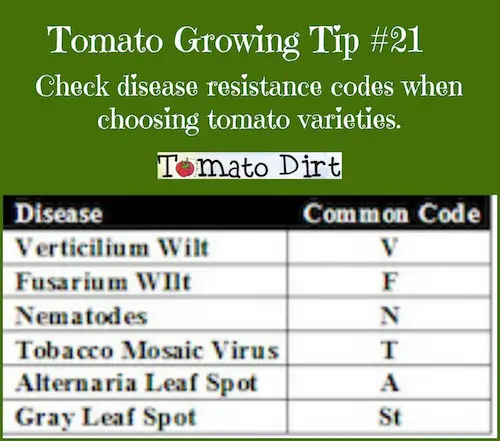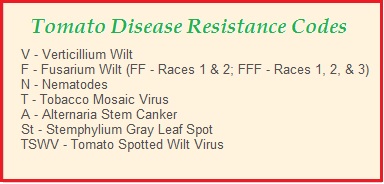How to Understand Disease Resistance Codes for Tomatoes
Since 2010, Tomato Dirt has garnered 4.8+ million views, making it the web’s leading online source for growing tomatoes in the home garden. Award-winning writer and Tomato Dirt owner Kathy Widenhouse has helped thousands of home gardeners grow healthier tomatoes. Be one of them when you get Tomato Dirt’s Growing Guide here.
Updated 6.16.24
Tomato disease resistance codes are listed on tomato seed packets or on tomato seedling labels. They appear in capital letters.
Here’s the dirt: many tomato varieties are bred specifically to resist particular diseases.
This is helpful information if you want to grow healthy plants! You can choose tomato varieties that are resistant to diseases that are common in your growing region.
When you see what looks like a confusing group of letters on plant or seed packets, never fear. You’re not buying classified information from a foreign country.
Instead, you’re looking at disease resistance codes, which are special gardening lingo for “here are some really good characteristics of this plant.” Each capital letter stands for a particular disease or pest.
Here’s how to decipher disease resistance codes.
Tomato Disease Resistance Codes
V Verticillium Wilt
F Fusarium Wilt
FF Fusarium, races 1 and 2
FFF Fusarium, races 1, 2, and 3
N Nematodes
A Alternaria
T Tobacco Mosaic Virus
St Stemphylium (Gray Leaf Spot)
TSWV Tomato Spotted Wilt Virus
An example may make things clearer
For instance, when you see a plant that has disease resistance codes VFN after its name, then it’s resistant to verticillium wilt, fusarium wilt, and nematodes. (All nasty stuff.)
Some explanation may help
What do each of these codes really mean?
“V” means the plant is resistant to the fungi that cause verticillium wilt, Verticillium albo-atrum and Verticillium dahliae. The fungi work their way up through the plant’s roots, clogging water-conducting tissue in the stem. They spreads a toxin that wilts leaves and prevents water from reaching branches and leaves, starving the plant. Yellow spots appear on lower leaves, followed by brown veins. Leaves then turn brown and fall off. Infection pattern often resembles a V-shape.
"F," "FF," or “FFF” means the plant is resistant to Fusarium oxysporum fungi that cause fusarium wilt. First signs are yellowing and wilting on one side of the plant – a leaf, single shoot, branch, or several branches. Yellowing and wilting move up the plant as the fungus spreads, clogging water-conducting tissue in the stem and affectively starving the plant. Left unchecked, fusarium wilt can kill tomato plants well before harvest time. Unfortunately, some fusarium fungi have overcome the initial “F” resistance attributes in designated tomatoes. Today, newer cultivars have been bred to be resistant to secondary fusarium strains – hence the “FF” and “FFF” designations.
"N" means the plant is resistant to nematodes, parasitic round worms that often lie dormant in the soil. Nematodes can produce root galls on the plant up to an inch wide. Affected plants are weak, stunted, do not respond to fertilizer, and tend to wilt.
"A" means the plant is resistant to the Alternaria alternata fungus that causes Alternaria stem canker. Brown or black cankers attack tomato stems, leaves, and fruit, often accompanied by streaks. Left unchecked, cankers can spread across the entire plant and kill it before harvest.
"T" means that the plant is resistant to the Tobacco Mosaic Virus (TMV), which causes mottling and yellowing in tomato leaves, reduced tomato size and yield, and brown fruit.
"St" means the plant is resistant to Stemphylium or gray leaf spot, caused by the Stemphylium solani fungus. Affected plants develop brown to black spots, which progressively get bigger, turn gray, and drop out – leaving holes.
"TSWV" means plants are resistant to the Tomato Spotted Wilt Virus. Symptoms vary from plant to plant, but can include yellow and brown rings on stems, brown streaks on p stems, dead leaf spots and tips, and severely stunted growth. Fruit may be discolored at maturity.
More on tomato diseases
Tomato diseases: how to identify, treat, and prevent them ...
How to choose the most disease resistant tomatoes ...
Different kinds of tomato blight and how to tell them apart ...
Fungicide for Tomatoes: A Primer...
How to identify and treat early blight ...
How to identify and treat late blight ...
How to identify and treat Septoria leaf spot ...
How to choose and apply fungicide to tomato plants ...
Verticillium wilt: how to identify and treat it ...
Fusarium wilt: how to identify and treat it ...
Bacterial wilt: how to identify and treat it ...
How to identify and treat tomato spotted wilt virus ...
Identifying tomato plant diseases: compare 5 kinds of tomato wilt ...
Get more info on our Tomato Diseases Pinterest board ...
Return from Tomato Disease Resistance Codes to Tomato Dirt home
As an Amazon Associate and Rakuten Advertising affiliate I earn from qualifying purchases.
SHARE THIS PAGE:
FREE! 10 Must-Know Tomato Growing Tips: 20-page guide
Get yours here:






New! Comments
Have your say about what you just read! Leave a comment in the box below.